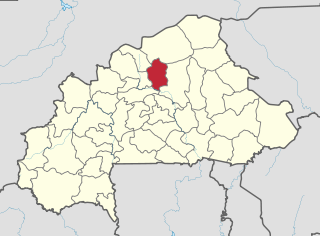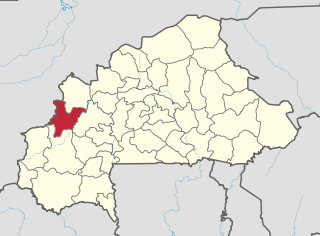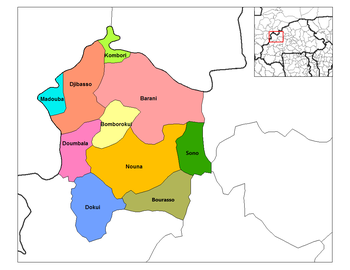
The Province de la Kossi lies in the western part of Burkina Faso and stretches to the border with Mali. It is in the Boucle du Mouhoun Region. The capital of Kossi is the town of Nouna, which has a mayor and high commissioner. The next largest town in Kossi is Djibasso, the last major town on the road from Nouna that heads west into Mali.

Bam is one of the 45 provinces of Burkina Faso. It is located in Centre-Nord Region and the capital of Bam is Kongoussi. In 2019 it has a population of 473,955. It is a rural province with 420,314 of its residents living in the countryside; only 53,641 live in urban areas. There are 229,786 men living in Bam Province and 244,169 women.

Banwa is one of the 45 provinces of Burkina Faso and is in Boucle du Mouhoun Region. The capital of Banwa is Solenzo. In 2019 it had a population of 345,749.

Bazèga is one of the 45 provinces of Burkina Faso and is in Centre-Sud Region. The capital of Bazèga is Kombissiri. Bazèga had a population of 238,202 in 2006 and in 2011 it was estimated to be 263,603.

Kouritenga is one of the 45 provinces of Burkina Faso, located in its Centre-Est Region. In 2019, the province had a population of 479,930. Its capital is Koupéla.

Namentenga is one of the 45 provinces of Burkina Faso, located in its Centre-Nord Region.

Tikare is a department or commune of Bam Province in north-western Burkina Faso. Its capital lies at the town of Tikare. According to the 2019 census the department has a total population of 52,263.

Balavé is a department or commune of Banwa Province in western Burkina Faso. Its capital lies at the town of Balavé. According to the 2019 census the department has a total population of 24,103.

Sami is a department or commune of Banwa Province in western Burkina Faso. Its capital lies at the town of Sami. According to the 2019 census the department has a total population of 13,596.

Bagré is a department or commune of Boulgou Province in eastern Burkina Faso. Its capital lies at the town of Bagré. According to the 2006 census, actualized for the municipal élections of 2019, the department has a total population of 37,855.

Niaogho is a department or commune of Boulgou Province in eastern Burkina Faso. Its capital lies at the town of Niaogho. According to the 2019 census the department has a total population of 25,547.
Zoaga is a department or commune of Boulgou Province in eastern Burkina Faso. Its capital lies at the town of Zoaga.

Bérégadougou is a department or commune of Comoé Province in southern Burkina Faso. Its capital lies at the town of Bérégadougou. According to the 2019 census the department has a total population of 15,164.

Moussodougou is a department or commune of Comoé Province in southern Burkina Faso. Its capital lies at the town of Moussodougou. According to the 2019 census the department has a total population of 17,288.

Coalla is a department or commune of Gnagna Province in northern Burkina Faso. Its capital lies at the town of Coalla. It has an area of 1,957 km2.

Barani is a department or commune of Kossi Province in western Burkina Faso. Its capital lies at the town of Barani. According to the 1996 census, the department has a total population of 49,144.

Dokuy or Dokui is a department or commune of Kossi Province in western Burkina Faso. Its capital lies at the town of Dokuy. According to the 1996 census the department has a total population of 40,588.

Doumbala is a department or commune of Kossi Province in western Burkina Faso. Its capital lies at the town of Doumbala. According to the 2019 census the department has a total population of 33,326.

Douna is a department or commune of Léraba Province in south-western Burkina Faso. Its capital lies at the town of Douna. According to the 1996 census the department has a total population of 9,132.

Gossina is a department or commune of Nayala Province in western Burkina Faso. Its capital lies at the town of Gossina. According to the 1996 census the department has a total population of 17,945. In reference to the 2019 census, the population had seen a surge and was 26, 241. The male were 12,606 while the women were 13, 635.
















